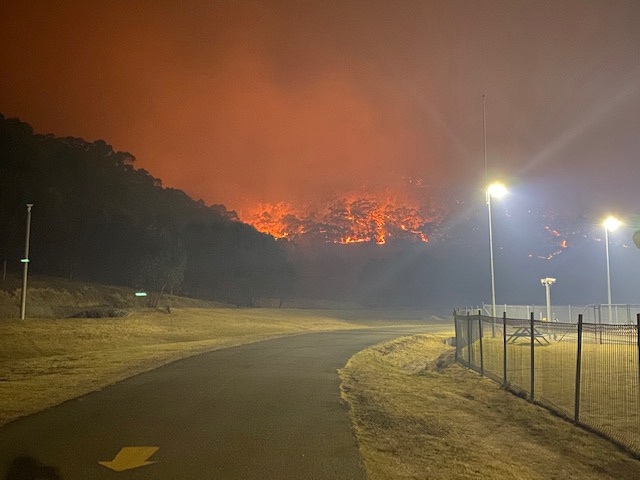Sydney, Australia
Reuters
Firefighters battling wildfires in Australia made the most of cooler weather on Sunday to access badly burnt towns and contain blazes before the expected return of hotter conditions at the end of the week.
The reprieve came as Prime Minister Scott Morrison defended both his government’s climate change policies and his decision to go on holiday to Hawaii last week.

A bushfire burns near the Lithgow Correctional Centre compound in Marrangaroo, New South Wales, Australia, on 19th December in this picture obtained from social media. PICTURE: Department of Justice New South Wales/via Reuters
The leader of New South Wales, Gladys Berejiklian, said “catastrophic” fire conditions on Saturday in parts of the Prime Minister’s home state had destroyed communities.
“We’ve got the devastating news there’s not much left in the town of Balmoral,” Berejiklian told journalists.
Balmoral is about 120 kilometres south-west of Sydney with a population of some 400. No fatalities were reported.
Morrison visited the Rural Fire Service headquarters in Sydney after returning on Saturday night from a holiday that drew sharp criticism as the wildfires crisis deepened.
After the deaths of two firefighters on Thursday night, Morrison announced he would return home early, and on Sunday he acknowledged his holiday had caused anxiety.
“I get it that people would have been upset to know that I was holidaying with my family while their families were under great stress,” Morrison said.
Nearly 100 fires were still burning across New South Wales late on Sunday afternoon, though none were rated as emergencies.
Conditions are expected to remain favourable over coming days allowing firefighters to work to contain fires encroaching on communities, particularly in the Blue Mountains region to the west of Sydney.
But authorities stated that large fires would continue to burn across New South Wales without significant rainfall, which is not forecast for many weeks.
“That’s still a way to go,” state Rural Fire Services Commissioner Shane Fitzsimmons said on Sunday.
“We’re still talking four to six weeks at best before we start to see a meaningful reprieve in the weather.”
Fitzsimmons said Saturday’s fire conditions may have added another hundred buildings to the tally of those already destroyed during this year’s fire season. Not all of those would be homes lost, he said.
Near the town of Lithgow, about 140 kilometres west of Sydney, one man who had been unaccounted for early on Sunday was later found safe.
Lithgow is also home to a prison facility, which the state’s Department of Justice said had significant capability to fight fires and was not evacuated. Staff and inmates were given masks on Saturday to protect against heavy smoke in the area.
Australia has been fighting wildfires for months as hot, dry conditions brought about an early start to the fire season, with blazes destroying more than 800 homes and close to 1.2 million hectares of bushland.
The states of South Australia and Victoria have also faced extreme fire conditions in recent days, with authorities in the former saying on Sunday that 72 homes had been destroyed by one fire.
Morrison addressed his conservative Liberal-National coalition’s climate policies on Sunday, which his government has been forced to defend following the severity of this year’s bushfires.
Morrison said there was no argument that there is a link between climate change and weather events around the world but said it was not credible make a direct connection to any single fire event and climate change.
Earlier this month, Australia drew criticism at a United Nations summit in Madrid for its climate-change policy of using old carbon credits to count toward future emissions targets.
Australia is one of the world’s largest carbon emitters per capita because of its reliance on coal-fired power plants. It has pledged to cut carbon emissions by 26 per cent by 2030 from 2005 levels, but critics accuse Morrison of a lack of action toward.
Morrison on Sunday re-committed to those policies, which he took to a general election in May.





